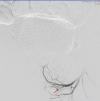Resistant pediatric priapism: A real challenge for the urologist
- PMID: 26609335
- PMCID: PMC4641879
- DOI: 10.5489/cuaj.2952
Resistant pediatric priapism: A real challenge for the urologist
Abstract
Priapism in pediatric patients is a rare entity. We present an 8-year-old boy with known cerebral palsy. He came to the emergency department with sustained painful erection for 12 hours. Physical examination showed rigid penis. Blood count and biochemical analysis were normal. Although penile Doppler ultrasound revealed normal arterial and venous flow, cavernosal blood gas was hypoxic. A total of 50 mL of dark blood was aspirated, and 2 mL of 0.001% adrenalin solution was applied to both corpus cavernosum, twice within 20 minutes, which eventually did not achieve detumescence. A distal Winter shunt was performed at the end of which the penis was semi-flaccid. By the 18th hour of surgery, the penis re-gained painful erection status, so an Al-Ghorab shunt was performed. After the Al-Ghorab shunt, the penis was still in the semi-flaccid state. The next day, an angiography was performed and an arteriovenous fistula was discovered and treated by embolization. The flaccid state was achieved and the patient was discharged the day after the embolization.
Figures
References
-
- Montague DK, et al. American Urological Association guideline on the management of priapism. J Urol. 2003;170:1318–24. doi: 10.1097/01.ju.0000087608.07371.ca. - DOI - PubMed
LinkOut - more resources
Full Text Sources
Other Literature Sources


